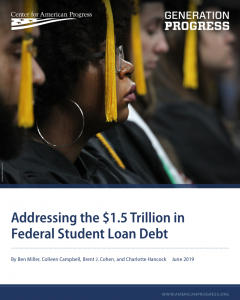REPORT: Addressing the $1.5 Trillion in Federal Student Loan Debt

Policymakers increasingly recognize the importance of bold ideas to address college affordability. Those ideas include Beyond Tuition, a plan that moves toward debt-free higher education, rolled out by the Center for American Progress.1Under the plan, families pay no more than what they can reasonably afford out of pocket, with additional expenses covered by a combination of federal, state, and institutional dollars. There are also strong proposals for debt-free college from Sen. Brian Schatz (D-HI) and for tuition-free college, including one from Sen. Bernie Sanders (I-VT), as well as calls for free community college championed by Sen. Tammy Baldwin (D-WI) and Rep. Bobby Scott (D-VA).2
As policymakers think about solving college affordability for future students, they must not forget about the tens of millions of borrowers already holding college debt. Fortunately, the policy community is starting to develop new ideas for current borrowers as well. For instance, multiple presidential campaigns have outlined policy proposals that forgive some student loans or make changes to repayment options.
No matter the proposal, solutions for current borrowers must go hand in hand with tackling affordability for tomorrow's students. About 43 million adult Americans–roughly one-sixth of the U.S. population older than age 18–currently carry a federal student loan and owe $1.5 trillion in federal student loan debt, plus an estimated $119 billion in student loans from private sources that are not backed by the government.3Moreover, college debt is even more concentrated among young people. An estimated one-third of all adults ages 25 to 34 have a student loan.4And while it is true that not every student borrower is in distress, student debt is an issue that both has an acute effect on many borrowers' lives and raises broader concerns for the overall economy.
Effectively targeting key stress points when it comes to the student debt crisis requires understanding the different ways student loans can and do create challenges for borrowers. For example, two-thirds of those who default on their student loans are borrowers who either did not finish college or earned only a certificate.5 At 45 percent, the average default rate for these individuals is three times higher than the rate of all other borrowers combined.6 The median cumulative student loan debt for all defaulters is rather low, at $9,625.7
By contrast, borrowers who completed a degree, especially at the graduate level, are less likely to default but may still face struggles related to repayment. For instance, the U.S. Department of Education projects that just 6 percent of the dollars lent to graduate students ultimately go into default, compared with 13 percent of funds lent to college juniors and seniors or a quarter of loans for students in their first or second year at a four-year institution.8 Graduate borrowers, however, might face a different set of challenges related to having unsustainably high debt burdens. More than one-third of borrowers who owe $40,000 or more–an amount of debt that only graduate students or independent undergraduates can obtain in principal–are paying their loans back on a repayment plan that ties their monthly payments to their income, suggesting that their student loan debt otherwise represents too large a share of their income.9 If these plans are not well managed by the federal government and easy for borrowers to use, they could put millions of individuals in financial distress. This could take a few forms, one of which is causing borrowers who use these plans to accumulate large amounts of additional interest that they must repay if they fail to stay on the plan or if their payments do not fully satisfy outstanding interest.
Broad breakdowns of borrowers by debt level and attainment status can also mask particular challenges related to equity. For instance, Black or African American students who earned a bachelor's degree had a default rate nearly four times higher than their similarly situated white peers.10 Students who are veterans, parents, first-generation college students, or are low income are also likely to face higher risk of default.11
This report considers different options for addressing issues for current borrowers of federal student loans. These solutions are meant to be independent of broader loan reforms, such as giving relief to borrowers whose schools took advantage of them. These options also presume keeping and preserving key existing benefits such as Public Service Loan Forgiveness (PSLF). Intentionally, this report does not endorse or recommend a specific policy. Rather, it assesses the benefits and potential considerations around a range of ideas, going from the most aggressive– forgiving all student debt–to more technical changes involving interest rates or repayment plans.
By examining the trade-offs and the targeting of each policy, the hope is that policymakers and the public can make the most informed decision when it comes to selecting which policy best supports their goals and values.
Overall, this report considers six options to tackle student debt:
1. Forgive all student loans
2. Forgive up to a set dollar amount for all borrowers
3. Forgive debt held by former Pell recipients
4. Reform repayment options to tackle excessive interest growth and provide quicker paths to forgiveness
5. Change repayment options to provide more regular forgiveness
6. Allow student loan refinancing
Understanding the potential implications of each of these policies, overlaid with considerations about equity, simplicity, aiming for broad impact, and whether the solution provides tangible relief, can provide policymakers with a clearer sense of the different ways to address the nation's $1.5 trillion in outstanding student debt.
